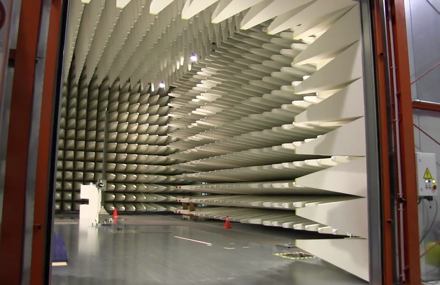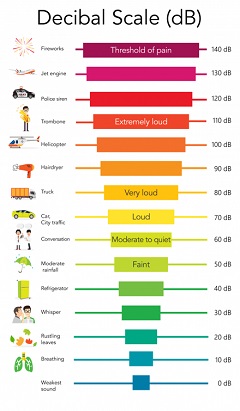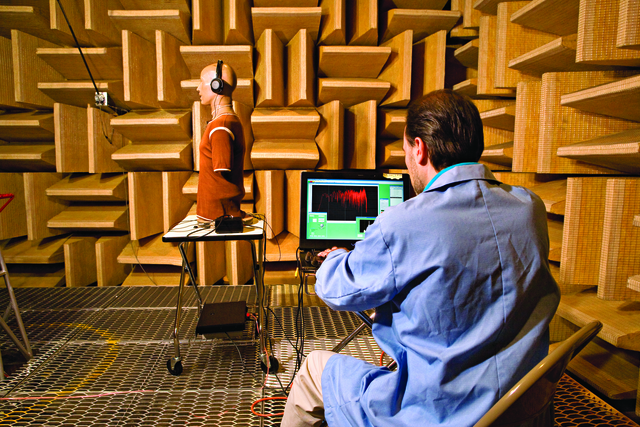
Soundproof
Build It!

| Ages | Cost | Time |
|---|---|---|
| 14+ | Medium | Full day |
Sound is all around us. Whether you are listening to music, watching a movie, chatting with a friend, or sitting alone outside in a park, we are constantly surrounded by all sorts of different sounds. In fact, we are so used to sounds that it can come as a bit of a shock to be in complete silence.
People often spend lots of money on speakers, earphones, and music systems to get as much sound as possible. But what about the reverse? Are there times when we just need less sound? Can you think of times when it would be useful to make a room soundproof – to keep sound from getting in or out? This is the kind of problem an acoustic engineer works on.
Your challenge is to design and build a soundproof box, one that will keep as much sound as possible from getting out. When you have perfected your stealthy soundproof box, share your design with the world at #nextengineersdiy.
This is a great project to do with your teacher or a group of friends. However, you can also design and build on your own. The choice is yours whether you want to work in silence or not! Once you are done, share your design with your parent or teacher and talk about what you have discovered.

These are the things that your design should be able to do or the things that will help determine if your design is a success.
These are limitations on your design. These are the things you cannot do when designing or what your design should not be like.
Engineers start by asking lots of questions. What problem must be solved? Who has the problem? What do we want to accomplish? What are the project requirements? What are the limitations? What is the goal? Through this process, engineers start to identify the criteria (the conditions the solution must satisfy to be considered successful) and the constraints (the limitations they need to design within).
Sound travels as a set of regular vibrations (a wave) through a medium like air, water, or steel. Solid materials like steel are good at transmitting these waves. Other materials, like thick fabric, tend to absorb the vibrations and dampen sounds.
Remember, sound waves travel because of the back-and-forth vibrations of particles in a medium. Therefore, sound cannot travel through a vacuum. As they saying goes, “No one can hear you scream in space.”
Here are some initial questions you might like to ask yourself as you start this challenge. Use the internet (ask an adult for permission if you need to) and speak to people you know well to help you.
Engineers dig deep into the problem by collecting information and data about the problem and any existing solutions that might be adaptable.
They talk to people from many different backgrounds and specialties to assist with this research.
We measure sound using decibels (dB). The quietest sound we can hear is defined as 0 dB. Every 10 dB thereafter corresponds to a sound that is 10 times louder. A whisper is 15 dB, a library is 45 dB, a normal conversation is about 60 dB, and a loud music concert can be up to 120 dB. Listening to sounds over 85 dB for a long time can damage your hearing.

Use the internet and speak to people you know to help you answer the following questions.
Now the fun really starts! Engineers start to brainstorm ideas and develop as many solutions as possible, sometimes even crazy ones! This is the time for wild ideas. Don’t judge any idea yet. It is important to build on the ideas of others while staying focused on the core problem and keeping the criteria and constraints in mind. For example, if there is a budget, can the potential solution be developed within that budget?
Once you have brainstormed and gathered a few designs, look at what you have and decide on the one you think is the best. Don’t worry, you can always change your mind later.
Make sketches of your design so that you have an idea of how you are going to build it and what materials, tools, and equipment you will need. No use designing something that needs stuff you can’t get.
Engineers choose one or more of the most promising solutions to prototype. A prototype is a model that works well enough to test part or all of the solution. The idea with prototypes is to build quickly and cheaply so that the costs of changing your mind or your design are not too high. Use prototypes to learn as much as you can about what works as quickly and as cheaply as you can.
Most prototypes fail, but that is good. It tells engineers which ideas they should focus on. Engineers also need to decide if the design really does solve the original problem.
You are going to need to put your prototype to the test. Do experiments with different designs and different materials. Play the same sound at the same volume inside your soundproof box and measure the sound escaping the box with a decibel meter each time. Remember to always measure the same distance away from the box and with the box and the decibel meter in the same orientation. The only part of each experiment that you want to be different is the design of the soundproof box itself. Everything else must be kept exactly the same.
Make sure that you record your results each time.
By answering these questions, you will be able to find the materials and design that work the best.
Remember, there is no shame in failing. All the best engineers fail ALL THE TIME. It’s what they do when they fail that makes them great: they learn and improve.
After learning through testing, engineers redesign and retest until they have the best solution possible – one that balances the criteria and constraints.
Remember that failure is not the end – it’s only the beginning. Think about how you can improve or optimize your design to make it as effective as possible. If you have met the initial 10 dB sound reduction target, can you improve upon this? Can you design a box that can stop even louder sounds escaping?
Even at this stage, feel free to go back to the drawing board if necessary and choose another of your original designs to try.
The most important thing is that you keep testing, learning, and improving.
Finally, engineers reach a point where they are satisfied with their solution. It does not need to be perfect, but it should ‘satisfice’ - meet the criteria within the constraints. Engineers now communicate their solution to others.
You can share your design however you like – a video, pictures, a blog – and on any platform you like. Just remember to tag #nextengineersdiy.
You can use any materials you like so long as you do not spend more than US$20 (or its equivalent). Remember to get the permission and/or supervision of an adult before you use any tools or equipment.
Here are some materials and equipment that you might find useful.
Here are some resources you might find helpful to get you started.
Sound is a special kind of energy. Watch this video from PBS to learn how sound travels and how we hear it.
We learn a lot about our surroundings thanks to sound. But... what is it exactly? Find out more in this Crash Course Physics video.
Watch a basic, cheap build option for a soundproof box.

Wikipedia's article on soundproofing covers a variety of methods for reducing sound pressure between a source and a receiver.
DIY Perks explores the possibility of making DIY sound absorption panels on a budget.
Danny Hauger walks through how to make your own mini soundproof box for audio recording.
If you need more of a challenge, here are some ideas to take your design to next level.